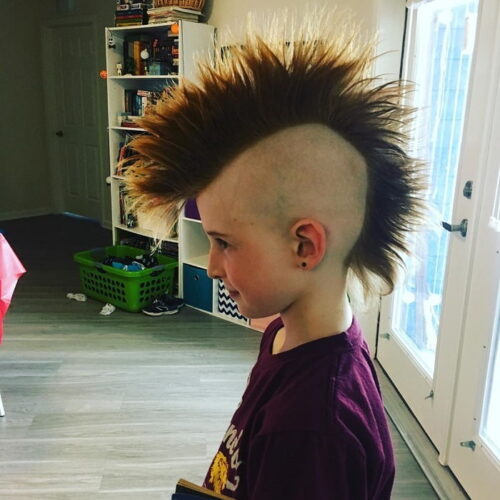Choose Your Battles With Teens Over Hair and Clothing
Mother and daughter; learning to ‘fly’
Adolescent Hair and Clothing Styles
Parenting: Choose your battles
by Gregory A. Barrett, M.D.
Of all my little sayings—and there certainly are a number of them—this is the one which always seems to generate the greatest controversy. Many parents upon receiving this nugget of advice become greatly disturbed and feel compelled to debate the point with great vigor, but in spite of all their well-intended efforts my opinion remains unchanged. The principle underlying this particular piece of wisdom is that during the rocky times of adolescence one must understand the major dynamic present and maintain an appropriate perspective and reasonable priorities.

When offspring are younger, they are like delightful little clones of their mommy and daddy — respectful, cute, well-behaved, wearing the clothes you picked out for them without complaint, sitting politely at your side when you take them to the barber shop or hair salon, following your every command without question or hesitation, an ever-present source of pride and pleasure. Life is good, is it not? But then, unfortunately, along comes Stage Two adolescence, where the task for the teenager becomes to separate from the parents and become a unique individual, a necessary and required step in developing into a mature, self-sufficient adult. This can often be a cold, disappointing, and challenging period for many as what the mother and father must now do is to accept this as the natural order and gracefully relinquish some control over their child’s life. Releasing authority is not easy, but it must be done, and it will be done—one way or another. They will either break loose from you kicking and screaming through overt rebellion or less dramatically with your understanding and acceptance. Many parents feel they must stand firm and strong in their resistance, that if they give in to their children on anything it will create a snowball effect. Well, they are mistaken. Change is going to happen anyway, that’s just how life is. And that is why it is critical not to expend too much energy arguing over matters which are not that important.

My daughter Rachel has gorgeous, thick, auburn hair, the kind of plumage most women would kill for, or gladly pay a stylist a small fortune to chemically manufacture. Or at least that’s how I remembered it; as, for a number of years, her natural color became something of a mystery. Rachel’s hair varied between brown, yellow, blue (my particular favorite), and gothic black, among others. It was short, then long, then dreadlocked (did you know that once hair is dreaded it can never be washed until it is undone?), and ultimately even “Britney-goes-into-rehab” shaved.
Kids use their hair and the clothing style of the day, to pronounce to the world and their peers their freedom, that they are a part of the current generation and not their parents’, and they must be allowed to express their individuality. We generally accepted Rachel’s hair machinations and her retro-hippy attire with grace and humor.
However, the “Never Argue…” adage was severely tested by the piercing of her nose on her eighteenth birthday and the strange, indecipherable tattoo which appeared on the back of her neck about a year later. However, I was ultimately able to persuade my wife that these too were simply a form of fashion, and we ultimately maintained our cool rather well. At least I did, anyway. Her mom? Ehh, to tell you the truth, not so good… but together we managed to get past it.
Choose your battles for the “Big Stuff”
Now, obviously, there are limits. A parent does have the right and the responsibility to set a limit regarding the amount of cleavage their middle school daughter is revealing, and advising their son regarding his choice of clothing to wear to his grandmother’s seventieth birthday party is appropriate. Of course, that should go without saying. Simply put, the point to be made here is the following: DON’T OVERREACT TO THE LITTLE STUFF.

This is an absolutely crucial concept to emphasize in effective parenting. A boy wants to let his hair grow down to his shoulders… no big deal. But, to firmly make it clear that he is never to get in a car when the driver has been drinking, that is a huge deal! Your daughter bought some clothes at the Salvation Army? Who cares? (Although I personally believe you should insist that they be washed first, before being worn for the first time.) But do care about her school performance. She puts purple streaks in her mane the night before class pictures… so what? Just laugh about it. Unprotected sex, on the other hand, now that is no laughing matter! Don’t force your ideas of fashion sense from twenty to thirty years previously upon your children. I would respectfully submit that you do not know the proper attire for a sixth-grade girl to wear to a Justin Bieber concert. You simply have no idea. So, don’t get involved.

The tighter parents try to hold on to the image of the child they’ve known and loved the previous thirteen-plus years, the harder the teenager will be forced to push back to free themselves from their suffocating grip. You have to give in on something, for the sake of yourself and for the sake of your child. Come on, you’ve done a good job so far; just realize that the game has changed. Accept the new rules and allow your children to begin to find themselves. Maintain a proper perspective. Remember back to your day when you were fighting the exact same battles over length of hair, clothes, music, et cetera? It wasn’t all that long ago when you stop and think about it—same arguments, different generations. Now it’s your turn to be the one in charge. Learn from the past and try to do a better job at this than your parents. It’s not nearly as hard as you would think.
Take my advice. Give in a little on trivial matters and they will hear you much more clearly when you need to discuss subjects which are truly important. Remember, at the end of the day, all of this is only fashion.
And in the final analysis that’s not really such a big deal, is it?
☤
Gregory A. Barrett, M.D.

Gregory A. Barrett, M.D. has only moved once in his life, from his small hometown to Columbus for the purpose of attending college. He graduated from the Ohio State University with a degree in English in 1974 and earned a Doctorate of Medicine from the Ohio State University College of Medicine four years later. Subsequently he performed an internship and residency in Pediatrics at Columbus (later Nationwide) Children’s Hospital where he received the Excellence in Clinical Teaching Award. Following completion of his residency Dr. Barrett was named Chief Resident of Pediatrics. In 1982 he entered private practice at Riverside Pediatrics.
Dr. Barrett has twice been the recipient of the Chester T. Kasmersky Award from the Children’s Hospital house staff for Outstanding Teaching and Practice of Pediatrics. He is a Clinical Associate Professor at OSU and has received the Distinguished Educator Award by the Ohio State School of Medicine, the highest honor given by the school for clinical teaching. In 2002 he was named one of the Best Family Doctors in America by the Ladies Home Journal. He has served as Chairman of the Department of Pediatrics at Riverside Methodist Hospital and is the past school physician for Upper Arlington Schools. In all three “Top Doctors in Central Ohio” surveys (2004, 2007, and 2010) voted by the physicians themselves Dr. Barrett was named the Outstanding Pediatrician. He is a founder and Executive Board member of Central Ohio Primary Care, the largest privately owned primary care physician group in the United States.
In 1976 Dr. Barrett wed Darla Hall, an elementary school guidance counselor from Youngstown, Ohio. Greg and Darla had two children, Rachel and Keith. They turned out okay. Rachel has an MSW from the University of Washington and is currently a school social worker working with behaviorally handicapped children in Seattle. Her brother Keith is a recent graduate of Capital Law School.
Dr. Barrett is a widower. His beloved wife of thirty-one years passed away in April, 2008, from complications of breast cancer. This site is dedicated to her memory.

